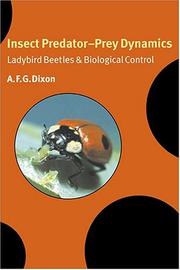| Listing 1 - 4 of 4 |
Sort by
|
Book
Year: 2000 Publisher: [Bozeman, Mont.] [Montana State University, Department of Biology, Fish & Wildlife Program]
Abstract | Keywords | Export | Availability | Bookmark
 Loading...
Loading...Choose an application
- Reference Manager
- EndNote
- RefWorks (Direct export to RefWorks)
Bird populations --- Birds --- Birds of prey --- Counting --- Estimates --- Habitat --- Nests --- Kevin Rim (Mont.) --- Montana --- Toole County
Book
ISBN: 2603014005 9782603014004 2603011863 9782603011867 Year: 2000 Publisher: Lausanne: Delachaux et Niestlé,
Abstract | Keywords | Export | Availability | Bookmark
 Loading...
Loading...Choose an application
- Reference Manager
- EndNote
- RefWorks (Direct export to RefWorks)
Birds of prey --- Birds --- Rapace --- predatory birds --- Comportement alimentaire --- Habitat --- habitats --- ecology --- Identification --- identification --- Reproduction --- reproduction --- Migration --- biological development --- Feeding habits --- Biogeography --- Europe --- habitats. --- identification. --- reproduction. --- Birds - Europe --- Raptors

ISBN: 9780521622035 0521622034 9780521017701 Year: 2000 Publisher: Cambridge : Cambridge University Press,
Abstract | Keywords | Export | Availability | Bookmark
 Loading...
Loading...Choose an application
- Reference Manager
- EndNote
- RefWorks (Direct export to RefWorks)
Ladybugs --- Predation (Biology) --- Insect pests --- Coccinelles --- Prédation (Biologie) --- Insectes nuisibles, Lutte biologique contre les --- Biological control --- Coccinellidae --- Lutte biologique --- Aphididae --- Zoologie --- Zoology --- Écologie animale --- animal ecology --- Comportement --- Behaviour --- Comportement alimentaire --- Feeding habits --- Relation prédateur proie --- Predator prey relations --- Prédation --- Predation --- Ladybugs. --- Biological control. --- Predation (Biology). --- Plant and Crop Sciences Plant and Crop Protection -- Biological Control -- Biological Control of Pests --- ALLW. --- Prédation (Biologie) --- Predation.
Article
Year: 2000
Abstract | Keywords | Export | Availability | Bookmark
 Loading...
Loading...Choose an application
- Reference Manager
- EndNote
- RefWorks (Direct export to RefWorks)
1. 1. The classic animal models for human psychiatric conditions involves rodents As prey species, their normal behaviors of avoidance would be considered pathological in humans and dogs. Hence, such models may not be homologous for similar behaviors found in psychiatric pathology in humans. 2. 2. Dogs exhibit pathological behavioral conditions that may be equivalent to certain human psychiatric conditions. These canine conditions appear spontaneously or endogenously in the absence of genetic or neurochemcial manipulation, and as such, may be homologous to the human condition. 3. 3. If canine conditions approach homology with human conditions they should have excellent face, predictive, and construct validity. 4. 4. The canine conditions of separation anxiety, obsessive-compulsive disorder, cognitive dysfunction, dominance aggression, and panic disorder have good to excellent validity at all explored levels for human generalized anxiety disorder, obsessive-compulsive disorder, Alzheimer's disease, impulse control disorders, and panic disorder. 5. 5. Natural canine models can aid our understanding of human psychiatric conditions.
Absence. --- Aggression. --- Animal model. --- Animal-model. --- Animal-models. --- Animal. --- Anxiety. --- Assessment. --- Avoidance. --- Behavior. --- Canine model. --- Cognition. --- Cognitive disfunction dog model. --- Cognitive dysfunction. --- Control. --- Disease. --- Disorder. --- Dog. --- Dogs. --- Dominance aggression. --- Dominance. --- Generalized anxiety disorder. --- Genetic. --- Human. --- Humans. --- Impulse control disorder. --- Level. --- Model. --- Models. --- Natural. --- Obsessive-compulsive disorder. --- Obsessive-compulsive. --- Panic disorders. --- Panic. --- Post-traumatic stress syndrome. --- Prey. --- Rodent. --- Rodents. --- Schizophrenia. --- Separation anxiety. --- Separation.
| Listing 1 - 4 of 4 |
Sort by
|

 Search
Search Feedback
Feedback About UniCat
About UniCat  Help
Help News
News